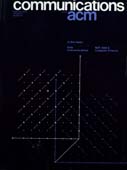February 1974 - Vol. 17 No. 2

Features
Attribute based file organization in a paged memory environment
The high cost of page accessing implies a need for for more careful data organization in a paged memory than is typical of most inverted file and similar approaches to multi-key retrieval. This article analyses that cost and proposes a method called multiple key hashing which attempts to minimize it. Since this approach is not always preferable to inversion, a combined method is described. The exact specifications of this combination for a file with given data and traffic characteristics is formulated as a mathematical program. The proposed heuristic solution to this program can often improve on a simple inversion technique by a factor of 2 or 3.
A cell organized raster display for line drawings
Raster scan computer graphics displays with “real time” character generators have previously been limited to alphanumeric characters. A display is described which extends the capabilities of this organization to include general graphics.
The feasibility of such a display is shown by deriving the minimum number of patterns required in the read only memory of the character generator to synthesize an arbitrary line. The synthesis process does not compromise picture quality, since the resulting dot patterns are identical with those of a conventional raster display. Furthermore, the time constraints of a raster display are shown to be satisfied for a typical design for very complex line drawings.
An approximate method for generating asymmetric random variables
Tukey's lambda distribution is generalized to provide an algorithm for generating values of unimodal asymmetric random variables. This algorithm has the same advantages as the symmetric random variable generator previously given by the authors, except that the addition of another parameter complicates the problem of finding the parameter values to fit a distribution.
The parallel execution of DO loops
Methods are developed for the parallel execution of different iterations of a DO loop. Both asynchronous multiprocessor computers and array computers are considered. Practical application to the design of compilers for such computers is discussed.
Production systems: or can we do better than BNF
Since the development of BNF, the definition of the syntax of programming languages has been almost universally associated with context-free requirements. Yet numerous interesting and difficult issues in syntax stem from the context-sensitive requirements, notably the compatibility between the declaration of an identifier and its uses, the correspondence between actual and formal parameters, and issues arising from block structure.
This paper explores the use of a formal notation called Production Systems in providing a readable and complete formal definition of syntax. As a practical illustration, a small but significant subset of PL/I is considered. A more detailed presentation, as well as the application to define abstract syntax and translations between languages, is given in a previous paper by the author.
The synthesis of loop predicates
Current methods for mechanical program verification require a complete predicate specification on each loop. Because this is tedious and error prone, producing a program with complete, correct predicates is reasonably difficult and would be facilitated by machine assistance. This paper discusses techniques for mechanically synthesizing loop predicates. Two classes of techniques are considered: (1) heuristic methods which derive loop predicates from boundary conditions and/or partially specified inductive assertions: (2) extraction methods which use input predicates and appropriate weak interpretations to obtain certain classes of loop predicates by an evaluation on the weak interpretation.



